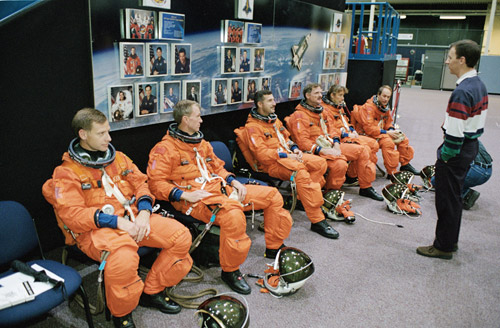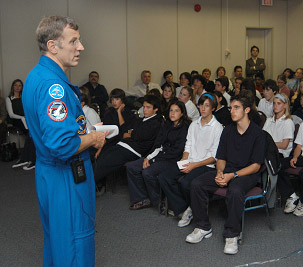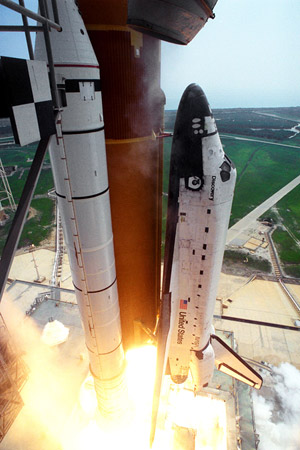|
| Canadian Astronaut Office - FAQs |
|
|
1. How can I become an astronaut?
Because so many people are fascinated with the idea of space travel, competition
for a coveted few astronaut positions is fierce. Among those individuals who are
selected, many have multiple degrees in medicine, science, and/or engineering,
while some have military training, and some have aviation flight experience. All,
however, are among the best in their chosen fields, and all are dedicated to
expanding our scientific knowledge to help improve the quality of life on Earth
and in space.
To improve your chances of becoming an astronaut, consider the following:
- Earn at least one advanced degree in science or engineering
- Become proficient in more than one discipline
- Develop your public speaking skills, preferably in both official languages
- Demonstrate concern for others by taking part in community activities
- Maintain your physical fitness
- OPTIONAL: learn to skydive, SCUBA dive, and/or pilot an airplane

Members of the STS-115 crew are briefed by United Space Alliance (USA) crew trainer David Pogue during an emergency egress training session in the Space Vehicle Mockup Facility at the Johnson Space Center (JSC). The crew is wearing training versions of the shuttle launch and entry suit. Image credit: NASA
Once selected for the astronaut program, astronaut candidates undergo continuous
and rigorous training to prepare for missions onboard the space shuttle and/or
onboard the International Space Station (ISS).
To confirm that you are well-suited to working in space, you may also want to
develop your interest in space in the following ways:
- Develop an understanding of topics in aerospace
- Work for an aerospace company to get hands-on experience
- Attend the International Space University (ISU)
Remember that becoming an astronaut is only one of many career possibilities in the
Canadian space program. Information about other careers available with the CSA can be
found in
our careers section.
Recruitment campaigns receive extensive media coverage and enable the CSA to
recruit candidates with the
necessary qualifications to become astronauts. To date, the next call has not
yet been set. Please wait for an announcement on our site and in the media before
sending your résumé to the organization handling the recruitment campaign.

2. What is an Astronaut?
Astronauts are specialists who fly in space in order to take advantage of the
weightless conditions of microgravity to conduct research in the
shuttle or on a space station. Their studies focus on space science,
space technology, and life sciences. Experiments are carried out both
on Earth and in space. Since November 2, 2000, astronauts have been living on the
International Space Station (ISS) on a permanent basis. Once the assembly of ISS is
complete, Canada will be expected to provide one astronaut to live on
ISS for a 3-month period, once every 3 years.
Canadian astronauts can be either Payload or Mission Specialists. Payload
specialists are astronauts whose major responsibility is to conduct
experiments on board the Space Shuttle. They receive intensive
scientific training as well as basic training in the operation of
orbiter systems. Mission specialists also operate experiment
apparatus. However, their prime responsibility is the operation of
orbiter systems including the Canadarm - often used for the deployment
and retrieval of payloads in orbit. Mission specialists are also trained
for Extravehicular Activities (EVA), such as needed for spacecraft
repairs and for operations in the orbiter cargo bay.

3. Is being an astronaut a long-term or a short-term job?
An astronaut's career can be a long-term or a short-term commitment, depending
on what type of astronaut a person is. Long-term astronauts, also called 'space
operations' or 'career' astronauts, train for and participate in a variety of
spaceflights that may include space shuttle missions or expedition assignments to the
International Space Station
(ISS). Short-term astronauts are usually 'invited' astronauts, who are sponsored by
industry or an academic institution to participate in either a short or long duration
mission to the International Space Station (ISS).

|
| CSA Astronaut Bob Thirsk simulates a manual descent during training for the Soyuz mission of April 2005. Thirsk is training as a back up flight engineer for Italian Astronaut Roberto Vittoni (ESA). |

4. How many Canadian astronauts are there?
Since the Canadian Astronaut Program was established in 1983, ten Canadians
have been selected to become astronauts. Currently there are six active Canadian
Astronauts. They are:
Julie Payette,
Dr. Steve MacLean,
Mr. Bjarni Tryggvason,
Dr. Robert Thirsk,
Dr. Dave Williams,
and Col. Chris Hadfield.
Dr. Roberta Bondar and Dr. Ken Money returned to their research activities in the summer of
1992, and Capt. Mike McKay resigned in 1995. In February 2001, Dr. Marc Garneau was appointed Executive Vice
President of the Canadian Space Agency, and became the president of the Canadian Space
Agency on November 22, 2001. He resigned from this position on November 28, 2005, to run for office in the federal election.

5. Who was the first Canadian to fly into space?
Dr. Marc Garneau became the first Canadian in space when he participated in mission
STS-41G in October 1984. He participated in mission
STS-77 in May 1996, and in November 2000 he flew to the International Space Station for mission
STS-97.
In February 2001, Dr. Garneau was appointed Executive Vice President of the Canadian
Space Agency, and became the president of the Canadian Space Agency on November 22,
2001. He resigned from this position on November 28, 2005, to run for office in the federal election.

|
| STS-97 mission specialist Marc Garneau arrives at the Shuttle Landing Facility aboard a T-38 jet aircraft. Image credit: NASA |

6. How can I contact an astronaut?
Unfortunately, because of the volume of e-mails they would receive if their addresses were public, astronauts' e-mails are confidential. However, you can send any correspondence to the
Webmaster or by writing to:
Canadian Astronaut Office
ATT. [Astronaut's name]
Canadian Space Agency
6767 route de l'Aéroport
Saint-Hubert, Quebec
J3Y 8Y9
If you would like to contact Dr. Roberta Bondar, please be advised that Dr. Bondar
retired from the Canadian Space Agency in 1992 to return to her research activities.
Contact information for Dr. Bondar is available on her
personal website.

7. How can I get an astronaut as a guest speaker for my special
event, organization, etc.?
If you are interested in inviting a Canadian astronaut to a public event,
please see Inviting
a Canadian Astronaut to a Public Event.

|
| CSA astronaut Dave Williams hosts a videoconference for a group of students with the NEEMO 7 crew, who are underwater off the coast of Florida. |

8. Where is the Canadian Astronaut Office, and do the astronauts
have to live by it?
The Canadian Astronaut Office is located at the Canadian Space Agency's
Headquarters in Saint-Hubert Quebec, near Montreal. For contact information see
Contact Us.
Canadian astronauts live wherever they are assigned to work. Although this
can include the Saint-Hubert area, astronauts may be assigned to work anywhere in
the world, particularly in Russia and the United States.

9. What are g's?
The things called g's are just a way to quantify force. The standard pull of
gravity is called '1 g.' It is defined as positive g, since it pulls down towards
your feet. If you stand on your head, you are experiencing 1 'negative'
g, and all the blood rushes to your head.
If you sit in an airplane and the pilot pulls back on the stick, you will
feel the acceleration as if gravity got stronger. Depending on how hard the pilot
pulls, you might experience 2 g, 3 g, or even up to 9 g (in an F-16!). At 9 g,
your 6-kilogram head would feel like it weighed 54 kilograms – hard to look around!
But your blood would get heavier too, and all rush towards your legs and feet. Your
heart would work hard to keep blood in your head, but at high g, unless you strain
very hard and wear a G-suit, the blood would drain from your head, and you'd
faint, or 'black out'.
As a reference, anything more than about 4 or 5 positive
g will black people out, unless they are trained to fight it.
Negative g will never cause a black out, because it pushes blood into your head.
You could cause high negative g by pushing on the stick. Most fighter airplanes are
only built to take about 3 negative g.
During a shuttle launch, the acceleration isn't up or down. It's more like a
dragster, accelerating forwards, and you feel like you're being pushed back into
your chair. The force is about 3 g, but since it's front-to-back, no one blacks out.
Finally, during shuttle landing, we do feel g up and down since it comes home
like an airplane. The max g we pull is during the turns to line up with the runway,
but the most we ever see is about 2 or 2.5 g. But after just a week of weightlessness
in space, even that feels heavy, and we wear g suits to help squeeze our legs
and abdomens to keep the blood in our heads.

10. How fast does the shuttle go?
The shuttle travels at 8 km per second. That is about 300 times faster than a
car on the freeway, and over 30 times as fast as an airliner. The shuttle has to
travel that fast to remain in orbit around the Earth. If it traveled any slower,
it would fall into the Earth's atmosphere, and if it traveled any faster, it would
fling out of orbit and into space. At 8 km per second, the shuttle can fly from one
end of Canada to the other in just ten minutes.

11. Can astronauts feel the variation in temperatures as
they pass through the different atmospheric layers?
On Earth, humans are attached to the Earth by gravity, at the bottom of a sea
of air that we call the atmosphere. This atmospheric 'shell' is very thin (about
2% of the Earth's radius) and is considered to be composed of many layers
(Troposphere, Stratosphere, Mesosphere, Thermosphere and Exosphere). These layers
are determined primarily by the changes in the atmospheric temperature. The warmest
area of the atmosphere is near the surface of the Earth (at the bottom of the
Troposphere) where we can feel the daily and seasonal temperature fluctuations.
The coldest area of the atmosphere is in the Mesosphere at around an altitude of
80-90 km, where the temperature drops to around -80oC. Very, very cold.
So do astronauts feel these temperatures variations as they travel through the
atmospheric layers on launch day? Fortunately not. Certainly the exterior surface
of the shuttle is exposed to these atmospheric temperatures, but the Flight Deck
and Mid Deck of the shuttle (where the astronauts live and work) has what is called
an environmental control system that regulates the interior of the shuttle to a
comfortable temperature. In addition, the astronauts wear a heavy pressure suit
(the big orange suits) during the launch and re-entry. These suits provide protection
to the astronauts in case there is a loss of pressure in the shuttle. However, these
suits are very big and hot, and as a result, they have their own environmental control
system to regulate the temperature. Even when an astronaut is performing a space
walk in the EVA suit, his or her EVA suit will also have an environmental control
system to help regulate temperature to an acceptable level. So during a space
mission, the astronaut is protected against the temperature extremes of the atmosphere
and does not feel the variations in temperature in the atmospheric layers.

|
| The STS-85 flight crew greets a crowd of well-wishers as they walk out to Launch Pad 39A, where they will take their places aboard the Space Shuttle Discovery. They are wearing launch and entry suits. Image credit: NASA |

12. How can I see a launch?
Space shuttle launches occur at the Kennedy
Space Center (KSC) in Florida. Please refer to the KSC website for more information
about how to watch a
launch from an official launch-viewing area.

|
| Launch of the Space Shuttle Discovery for the 11-day Mission STS-85, on August 7, 1997, with CSA Astronaut Bjarni Tryggvason aboard. Image credit: NASA |

13. How long does it take to get to the space station?
Learn more in Kidspace

14. What is the longest time anyone has ever spent in space?
Russian cosmonaut Sergei Krikalev holds the record for the longest total stay in space, clocking 803 days and 9 hours and 39 minutes. Another Russian cosmonaut, Dr. Valeri Polyakov, holds the record for the longest continuous stay in space. Dr. Polyakov stayed in space for 437 days, 17 hours and 38 minutes (14 months) on Mir, from January 1994 to March 1995.

15. How many space stations are there?
There is currently only one space station. It is called the
International Space Station
(ISS), and it is being built by many nations. Once fully assembled, the Space
Station will cover an area as large as a football field (108 metres long) and weigh
close to 450 metric tons. In the past, there have been several other space stations
– in the 1970s the United States operated one called Skylab, and the Russians have
had several small ones called Salyut 1 through 7. The largest space station prior
to the ISS was the Russian space station Mir (a Russian word that means peace),
which remained in space for 16 years.

16. Do female astronauts get their period in space?
Yes, female astronauts get their period in space just like they do on Earth,
and no menstrual problems have been associated with living in microgravity. In
the early years of human spaceflight, some worried that women would not have
their periods safely in microgravity. They thought that microgravity might cause
menstrual fluid to travel upwards into the body instead of out of it – also
called retrograde menstrual flow. This would mean that blood would flow from the
uterine cavity into the fallopian tubes and then into the pelvis and abdomen,
causing pain and increasing the risk for endometriosis. While this has not been
observed in past space missions, more studies are needed to better understand how
the body works and reacts to microgravity.

17. The Canadian astronaut medical selection standards for non-pilot astronauts requires visual acuity to be 20/200 or better uncorrected and correctable to 20/20 in each eye. What does visual acuity correctable to 20/20 mean?
To ensure astronaut health and safety in the space flight environment, astronauts must meet a number of medical standards that are similar to a military or civilian flight physical. Visual acuity or the eye's ability to see detail is one of the many standards used to screen candidates for spaceflight.
20/20 vision is the "normal" standard of sight that has been determined by eye doctors. This means that standing 20 feet away from an eye chart you can see what a "normal" person sees at 20 feet from the chart (the first number is your distance from the chart and the second number is a normal persons distance from the chart). It is important to remember that 20/20 is not "perfect" vision. It is possible for some people to have better vision than what is considered "normal". 20/10 vision means that at a distance of 20 feet from an eye chart you can see what a "normal" person sees at 10 feet away. Poor eye sight such as 20/40 means that when you are standing 20 feet from an eye chart you see what a "normal" person sees at 40 feet from the chart. Any vision less than 20/200 is considered legally blind in both Canada and the United States. Visual acuity correctable to 20/20 means that when a person wears glasses their sight is corrected to 20/20 or "normal".

18. Why is laser eye surgery not accepted under the Canadian astronaut medical selection standards?
LASIK (Laser assisted in situ keratomileusis) or laser eye surgery is one type of refractive surgery used to correct vision. In the procedure a flap is created in the cornea, the outer layer of the eye. A laser is used to change and reshape the cornea and then the flap is put back into its original position. LASIK does not guarantee perfect vision and there still exists a chance that patients will need to wear glasses or contact lenses for some activities. The outcome is not the same for every patient.
The Canadian astronaut medical selection standards are based on those of the International Space Station. While other forms of correction (such as glasses) are accepted in the space program, any form of refractive surgery, whether it is for cosmetic or medical reasons, disqualifies a candidate. Currently, there is not enough research to fully understand how the flap created in surgery will behave in microgravity or during physically demanding astronaut training. Other reasons for turning away candidates include: long term results are not well understood; correction is often not permanent; problems with glare, especially at night, have been reported; and a chance of scarring or swelling of the cornea. At this time it is uncertain whether this procedure will be accepted in astronaut candidates in the future.
For more information on vision see www.howstuffworks.com/question126.htm
For an explanation on LASIK procedures see www.eyesurgeryeducation.com
|
